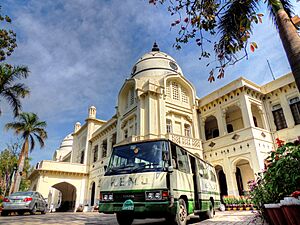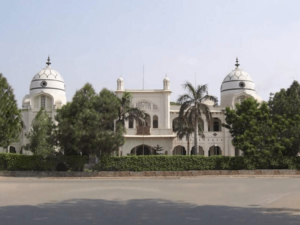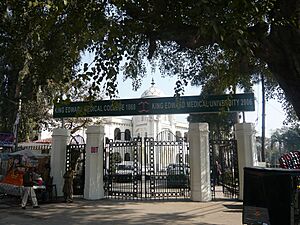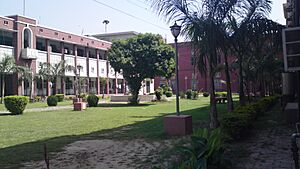King Edward Medical University facts for kids
|
کنگ ایڈورڈ میڈیکل یونیورسٹی
|
|
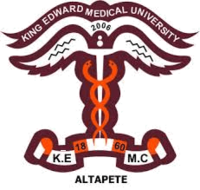 |
|
| Motto | Altapete |
|---|---|
|
Motto in English
|
Aim high |
| Type | Public |
| Established | 1860 |
| Vice-Chancellor | Mahmood Ayaz |
|
Academic staff
|
N/A |
| Students | 325 |
| Location | , , |
| Website | https://kemu.edu.pk |
King Edward Medical University (often called KEMU) is a public medical university in Lahore, Punjab, Pakistan. It started as the Lahore Medical School in 1860, during the time when the British ruled India. It was named after King Edward VII.
In 1868, students from the Lahore Medical School were given special recognition by Trinity College Dublin, similar to students from English schools. Later, in 1871, Mayo Hospital became connected to the university as a teaching hospital. In the same year, the college joined the University of the Punjab. By 1887, Lady Aitchison Hospital also became a teaching hospital for the university.
After Pakistan became independent, this university was the only medical college in its province. In 2005, it became a full university, meaning it could give out its own degrees. Since then, it has grown a lot and now works with seven large hospitals, including the Lady Willingdon Hospital.
KEMU has a long history of training excellent doctors. These doctors have worked in Pakistan and all over the world, including the US and UK. Many KEMU graduates successfully pass important medical exams to practice in other countries each year.
Contents
History of KEMU
King Edward Medical College began in 1860 as the Lahore Medical College. It is one of the oldest medical schools in South Asia. Only a few others, like Medical College Kolkata (1835) and Madras Medical College (1835), are older.
The first main building for studies was finished in 1883. On December 21, 1911, Lahore Medical College was renamed King Edward Medical College. This was done to honor the late King and Emperor. Then, on May 12, 2005, it became a full university, able to grant its own degrees, and was named King Edward Medical University.
Campus and Departments at KEMU
The university has many different departments where students learn about medicine. These departments are grouped into basic sciences, medicine, and surgery.
Basic Science Departments
These departments teach the fundamental knowledge needed for medicine:
- Anatomy (study of the body's structure)
- Biochemistry (study of chemicals in living things)
- Physiology (study of how the body works)
- Pathology (study of diseases)
- Pharmacology (study of medicines)
Medicine and Allied Departments
These departments focus on treating illnesses:
- Cardiology (heart health)
- Pediatrics (children's health)
- Dermatology (skin health)
- Neurology (brain and nervous system)
- Psychiatry and Behavioural Sciences (mental health)
- General Medicine (overall health care)
Surgery and Allied Departments
These departments focus on medical procedures:
- Anesthesiology (pain relief during surgery)
- Cardiac Surgery (heart operations)
- Neurosurgery (brain and spine operations)
- Obstetrics and Gynaecology (women's health and childbirth)
- Orthopedics (bones and joints)
- Plastic Surgery (reconstructive surgery)
- General Surgery (common operations)
Hospitals Connected to KEMU
KEMU works with several hospitals where students get hands-on training:
- Mayo Hospital Lahore
- Lady Willingdon Hospital
- Lady Aitchison Hospital
- Nawaz Sharif Hospital, Yakki Gate, Lahore
- Nawaz Sharif Hospital, Kot Khawaja Saeed, Lahore
- Shahdra Hospital
- Govt. Said Mitha Teaching Hospital Lahore
- Mian Munshi Hospital Lahore
Special Institutes and Schools
The university also has other centers for specific studies:
- Centre For Nuclear Medicine (CENUM)
- College of Ophthalmology and Allied Vision Sciences (COAVS)
- School of Nursing
- School of Physiotherapy
Student Facilities
Students at KEMU have access to:
New Buildings and Campuses
After becoming a university in 2005, KEMU built new facilities. A new campus building was finished in 2019. Another building, the Maqbool Ahmad Block, was built with a generous donation. This block houses departments like Biochemistry and Pharmacology. It also has auditoriums for university events. The university is also planning a new campus outside Lahore.
Degrees Offered at KEMU
KEMU offers various degrees for students who want to become doctors or work in related health fields.
Undergraduate Degrees
- Bachelor of Medicine and Bachelor of Surgery (MBBS): This is the main degree to become a doctor.
- Bachelor of Science (B.S.(Hons)) in Allied Health Sciences: For other health professions.
- Doctor of physical therapy (DPT): To become a physical therapist.
Postgraduate Degrees
These are for doctors who want to specialize further:
- Doctor of Philosophy (Ph.D.)
- Doctor of Medicine (MD)
- Master of Surgery (MS)
- Master of Philosophy (M.Phil.)
How KEMU is Organized
King Edward Medical University is led by a Vice Chancellor. Currently, this role is held by Professor Dr. Mahmood Ayaz. The university has over 1300 undergraduate students and more than 800 postgraduate students.
To get into KEMU for undergraduate studies, students need to have high scores in their previous exams and an entry test. The university looks at marks from the Higher Secondary School Certificate (HSSC) exam, the entry test, and the Secondary School Certificate (SSC). The entry test usually happens in September.
The MBBS program takes five years to complete. After graduating, students do a one-year internship (called a house job) at Mayo Hospital or another government hospital. This internship helps them get practical experience. After finishing the internship, doctors get their full registration from the Pakistan Medical and Dental Council (PMDC).
Student Societies at KEMU
Students at King Edward Medical University can join many different clubs and societies. These groups help students develop their skills and interests outside of their studies.
Some of the student societies include:
- King Edward Literary Society URDU (KELS URDU): The oldest society, started in 1882.
- King Edward Debating Society (KEDS): Active since 1887.
- King Edward Literary Society English (KELS ENGLISH)
- Kemcolians' Arts & Photography Society (KAPS): A very popular official society.
- Students' Patients Welfare Society (SPWS): Focuses on helping patients.
- Kemcolians' Sports Club
- Kemcolians' Dramatic Society (KDS)
- Kemcolians' Akhuwat Club: A social welfare group.
Students from these societies often compete in national and international events and have won many awards. The university also has its own magazine, KEMCOL, which is managed by students. Students and graduates of KEMU are known as "Kemcolians."
Alumni Association
Former students of King Edward Medical University, known as alumni, have their own associations. These groups help alumni stay connected and support the university.
- The King Edward Medical College Alumni Association of North America
- The King Edward Medical College Alumni Association of the United Kingdom
- The King Edward Medical College/University Alumni for all Kemcolians
Notable Alumni
Many famous people have graduated from King Edward Medical University, including:
- Riaz Haider MD – An American cardiologist and former president of the American Heart Association.
- Ayub Ommaya MD – A neurosurgeon who invented the Ommaya reservoir, a device used in medicine.
- Amjad Saqib – A social entrepreneur and author.
- Afzal Javed – A psychiatrist and academic, who was President of the World Psychiatric Association (2020–2023).
- Faisal Sultan – An infectious diseases physician and former CEO of the Shaukat Khanum Memorial Cancer Hospital and Research Centre.
- Farid Ahmad Khan – A Pakistani plastic surgeon.
- Farrukh Siyar Hashmi – A British Pakistani consultant psychiatrist known for his work in race relations in the UK.
- Nazir Ahmad – A neurosurgeon.
- Syed Muhammad Najeeb – A well-known Medical Professor and Internal Medicine specialist.
See also
- Education in Pakistan


